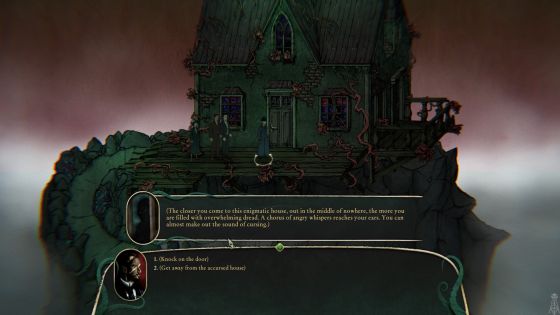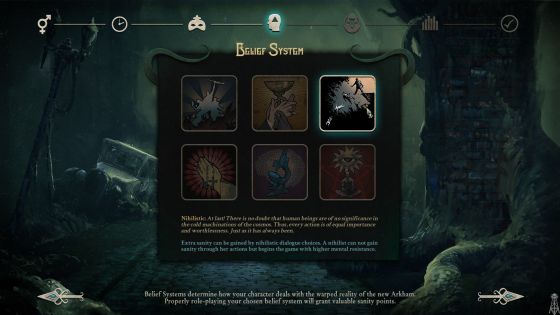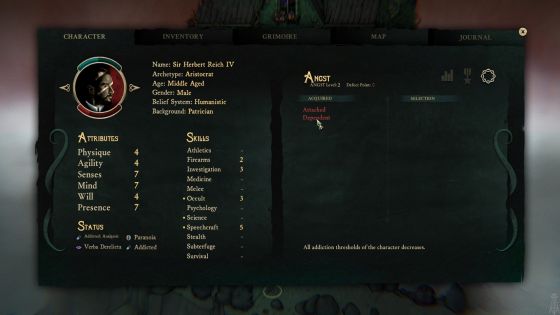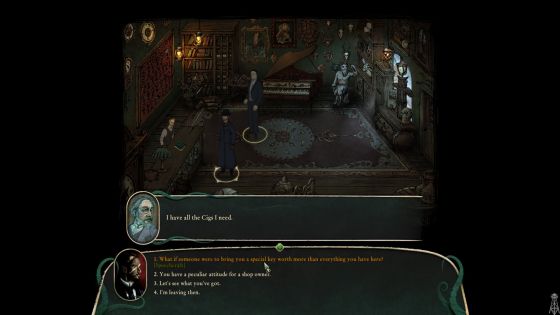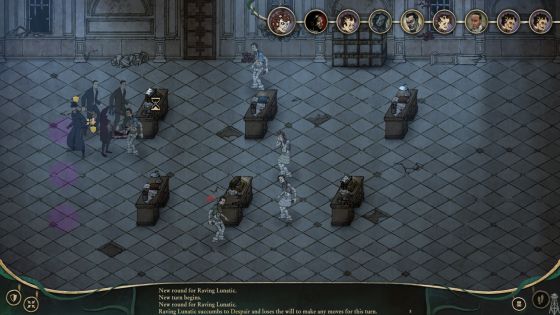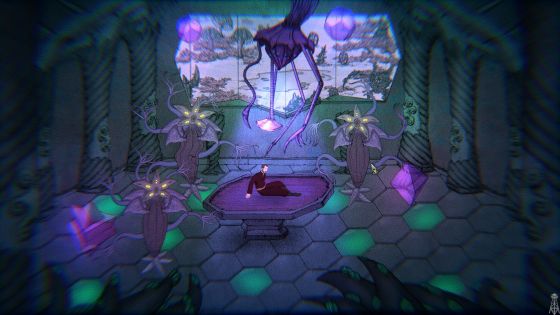Stygian: Reign of the Old Ones Review

Turned out of my ancestral home by a mob of cultists and gangsters, and with only loyal butler Werner helping me, I wake up from a horrible dream in a seedy tavern in the city of Arkham. That was the beginning of my aristocratic character's journey into Stygian. Stygian is a horror RPG based on the pen and paper RPG Call of Cthulu, which in turn is inspired by the works of horror writer H. P. Lovecraft. In Stygian you don't play a hero, but at best a somewhat capable person who has to survive unimaginable horrors. And in this case survival doesn't only mean not dying, but also not succumbing entirely to madness. As a result, you'll find that having your character run away from battle or taking drugs or drinking alcohol is often preferable to fighting against hopeless odds and using up precious ammunition or spiraling into insanity. Stygian's visuals are drawn out of pulp comics, and this along with its unusual mechanics and setting make it a pretty unique RPG, which stands out against the mass of fantasy, sci-fi, and post-apocalyptic RPGs flooding the market. But Stygian is also a game made on a tight budget, and unfortunately that limits its otherwise excellent potential.
Story and Atmosphere
I'll come right out and say it. This is where Stygian really shines. Stygian is a game for readers. Most items and many areas have a colorful text blurbs. Events are also narrated in detail and you'll enter into lots of branching dialogue.
A lot of things in the game have picturesque descriptions.
Your character finds themselves dispossessed and restless in the city of Arkham. The city has recently been swallowed by an unnatural darkness and is apparently cut off from the outside world. To make matters worse all legitimate order has collapsed, and the city has been taken over by cultists and criminals. In your nightmares a mysterious stranger hints at a way out. Following the clues from your dream your character travels in and around Arkham, through the dream world, and what lies beyond. Stygian's story is dark and well told.
Stygian also gives you plenty of chances to roleplay your character. You get to pick a belief system at the game's beginning. Your character can be humanistic, hedonistic, nihilistic, rational, religious, or esoteric. These give additional dialogue choices. And the dialogue choices in turn can reward you by helping you recover small amounts of sanity if you choose to stay true to your beliefs. Of course, you aren't forced to. Also, your characters profession acts as a background, which can give you a starting companion, and also influences some dialogue choices. Stygian's companions are also each very unusual and they often wish to discuss your journey with you. They give you another chance to define who your character is, even if there isn't really any party banter between your companions.
The belief system is a well implemented role playing system which somewhat corresponds to the alignment system in D&D games.
Whether it's the characters, quests, dialogues, or level design, all elements of Stygian contribute to its Lovecraftian atmosphere. Stygian's horror is built up by a feeling of dread. There is no escape from your character's slow descent into insanity. There is little hope against alien horrors or the mass of evil people who control the city. What we don't see is the excessive gore, absence of light or unexpected surprises, that a lot of AAA horror games use to try to scare players. So Stygian isn't necessarily what some players might expect in a horror RPG. Nevertheless, the game stays very true to the the Call of Cthulu tabletop game and Lovecraft's works, and fans of the game or author will be pleased by how well the developers successfully created the game's atmosphere.
My companion wants to talk to me about events that just occurred. These discussions help me learn more about him and myself.
Character Development.
Stygian has what appears to be a class system, but in reality the only mechanical benefits of having a class are your starting skill points, equipment and background. Also, you can only max out two class skills, but this wasn't an issue in my playthrough. Otherwise, the game's character system resembles a classical classless point buy system, which gives your main character complete freedom to invest in a number of combat and noncombat skills. While there is some mandatory combat in Stygian, non-combat skills prove very useful in many situations. They give alternative solutions to many quests and additional dialogue options. A number of them are also useful during rests. Your character only recovers a moderate amount of health during rests, which is not sufficient to heal heavily wounded or mentally damaged characters. Some skills and items can be used to increase health or sanity regeneration. Characters with the medicine or science skills can also research crafting recipes during rests. Those with the occult skill can research spells and rituals or identify magical items. Survival helps prevent attacks when sleeping outside of Arkham. While your character has total freedom to pick their skills, your companions do not. Each companion has only a couple of predetermined combat and non-combat skills.
The Angst system offsets your character's growing power with increased mental instability.
Stygian also has a perk system. Every level up, your main character can choose positive perks depending on how high their skills or attributes are. Defects (negative perks) are gained when the angst bar is full. Most angst is gained in combat, either from losing sanity, getting hit, or even running away. So even though combat grants positive experience which helps your character level up, it also has negative consequences. Most defects increase the number of situations in which you lose sanity. A minority decrease your character's combat effectiveness, resistance to addicition, or change dialogue options. By the last half of the game there is almost no way to avoid sanity damaging defects. Your game can end both from losing all health or all sanity, and while its possible to be killed outright in a fight, sanity loss is much more constant, even outside of combat. As your character gains levels and gets better equipment dying becomes less of an issue, but at the same time the accumulation of defects makes insanity an ever-increasing danger late in the game. Your companions don't suffer from defects, but only have a limited number of perks to choose from. These aren't generic perks either, but are directly related to who or what their character is, which adds to the atmosphere of the game.
Skills give alternative dialogue paths in addition to alternative quest solutions.
Game Mechanics
Stygian starts out in the city of Arkham, which is the hub of the game for about the first 2/3 of the game time. As you travel through the city, talk to its inhabitants, and visit its locations, you will find new quests, which will also open up locations outside of the city. This part of the game has a very open feel. You will soon find that you have a number of quests in your journal in different places and you can do them in any order you choose. A few areas require you to fight opponents to progress. Some combat can be bypassed by using different skills.
Many areas and quests have more of an adventure game feel to them. You will often need to find the right item to advance the game. There are also puzzles you'll need to complete. A lot of the game is spent in dialogue, and you'll often have to talk to a number of people in order to solve certain quests. It is positive that a number of quests have multiple solutions, whether it is having a high enough skill, attribute, acquiring the correct item, or winning a combat. In general, Stygian has less combat than most RPGs, but it certainly has enough that you'll probably want your main character to have a combat skill as at least as a secondary skill. Stealth can be useful to evade some combat, and magic can be very powerful, but casting spells damage your character's sanity. Most magic spells must also be found and researched, so at the start of the game, it's a fairly limited option.
In Stygian you control up to three characters. These include your starting character and two companions. You can actually have up to 4 characters in your party, but the last character is a follower. Followers are temporary characters, and you don't have control of their character development or inventory, though you usually can control them in combat. One follower is a mercenary you can hire early on. The others might join up as part of a quest, but in any case, you can only have one in your group at any time.
Spells are powerful, but costly.
When I played Stygian, combat moved fairly slowly. A recent patch has given players the option to speed up combat, which should make combat more enjoyable. Combat is somewhat basic and mostly consists of standard attacks. Still, placement and movement of your characters are important and being attacked from behind means taking extra damage. Enemies will try to move to your exposed rear, so you need to be careful not to let a character get surrounded. You can only send a character with a limited number of consumables, mostly drugs, into combat. These are quite powerful, offering the game's only healing, or giving stat buffs or extra action points. However, they cost a fair amount of money, and overusing them can quickly result in addiction. Becoming addicted means either feeding the addiction or entering withdrawal which gives longer term penalties to stats. Therefore, one has to weigh the short-term benefits of drugs against the long-term damage. Magic also is powerful, but costly since it damages sanity. In general, the combat in Stygian is servicable, if not great, but since its not really at the center of the game, like it is in other RPGs, it doesn't seem like as big of a drawback in the game as it otherwise would.
Combat is in principle simple, though cover, attack direction and placement can make the difference between victory and defeat.
While the first 2/3 of Stygian (which took me just over 16 hours to complete) is very open, the last 1/3 of the game is fairly linear. Many (but not all) of the individual locations in the last part of the game are quite unique, interesting and well designed. Nevertheless, the last 1/3 of the game exposes a few of the game's design weaknesses. Stygian's quests often require a lot of backtracking, since talking to certain NPCs or getting certain items is the only way, or the most advantageous way to advance a quest. That's fine if you have tons of quest that are near the hub, since your character has many things which they'll need to get done in the vicinity of other quest locations. But in the end of the game you have to backtrack longer and are mostly following just one quest. Also, there is no other hub than Arkham. I was a bit surprised when the game told me I was at the point of no return, and rather than trudging back to Arkham and then returning which would have been a long and dangerous trip, I decided to press on with a lot of money and less than optimal equipment. To Stygian's credit I was still able to finish the game, largely by running away from or otherwise avoiding combat near the end of the game. I also felt Stygian ended somewhat abruptly. While the end itself offers an interesting twist, from the quest log and introduction I expected the game to continue on to at least one more location. So In the end I was left wondering if the game ended as intended or whether another area was initially planned and not realized due to budget limitations.
Presentation
Stygian's art style is very unique. Its visuals are based of the illustrations of pulp horror comics. This gives the game a very distinctive style. I found this an interesting choice, because many of the modern Cthulu based horror games like Conarium or Call of Cthulu are first person games with realistic graphics. In these games you don't know what's lying around the corner and things like flickering lights or blurry vision can convey a sense of dread or helplessness. The pulp horror cartoon isometric look of Stygian on the other hand might make more sense for a game with a limited budget and with a party of characters rather than a single character. The game's art direction in any case is well done, and its characters are distinctive. However, I am not sure the art style will appeal to everyone. The game has a bit of voiced narration at the beginning and end, but otherwise the mass of the game's dialogue is silent and has to be read. The sound and music fit well with the game's atmosphere and art style.
The pulp comic look of the game doesn't take away from the game's excellent art direction, but it might not be everyone's cup of tea.
Conclusion
I really enjoyed the first 2/3 of Stygian and would like to replay through it at some point. That's a rare thing for me and usually a sign that I think a game sticks out above the crowd of rather decent, but less than memorable RPGs, which are flooding the market now. Stygian has memorable quests, a well- designed world and an unusually creepy atmosphere. Unfortunately, the last third of the game just doesn't fit together nearly as well and felt somewhat incomplete to me. And that stands in the way of me giving Stygian a very good game rating and being able to recommend it unconditionally. Many elements of Stygian resemble an adventure game. While it is not too heavy on puzzles, it is also not too heavy on combat. Players will be spending a lot of time reading texts, engaging in conversation, and gathering items. So, you'll need to judge in advance if that is your kind of thing before picking up the game. And lastly if you're looking for an epically long rpg, Stygian won't satisfy you. It will probably clock in to between 15-20 hours depending on how much combat you avoid, and how long it takes you to figure out what to do in certain quests.
This is a rather unsettling place to awaken.
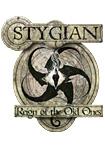
Information about
Stygian: Reign of the Old OnesDeveloper: Cultic Games
SP/MP: Single-player
Setting: Historical
Genre: RPG
Combat: Turn-based
Play-time: 10-20 hours
Voice-acting: Unknown
Regions & platforms
Internet
· Homepage
· Platform: PC
· Released: 2019-09-26
· Publisher: 1C Company
More information
Other articles
Summary
Pros
- Excellent Lovecraftian atmosphere
- Great pen and paper feel
- Good writing
- Multiple solutions for a number of quests
- Rather unique in setting and systems
Cons
- Last 1/3 of the game weaker and more linear than the rest.
- 15-20 hour playing time might be too short for some.
- Simple combat is functional, but not exciting.
- Ending feels somewhat abrupt


